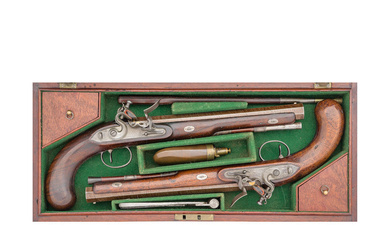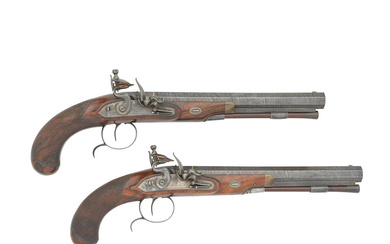A Pair Of 28-Bore Flintlock Duelling Pistols, By Robert Wogdon Of London, Circa 1785-90
With browned twist octagonal sighted barrels (early 19th century working replacements) each engraved 'William Morris Perth' along the top flat, silver fore-sights, platinum-lined touch-holes, breech tang with transverse band of engraved beadwork in front of the back-sight and flowering foliage behind, border engraved flat bevelled detented locks (two side nails replaced) each signed on a gold oval centred on engraved drapery, the stepped tails, safety-catches, cocks and steels all with engraved foliate decoration, the last with small roller working on the blued steel-spring, and gold-lined pans, figured half-stocks (one with minor old repair along the upper edge on one side) each with swelling flat-sided butt and dark horn fore-end cap (one incomplete), border engraved blued steel mounts comprising butt-caps each decorated with foliage and a flower-head centred on the retaining screw, trigger-guards each with acorn finial and decorated with a garland along the bow, and turned rear ramrod-pipes, set triggers, horn-tipped wooden ramrods, one with iron powder-measure, and some original finish (2)
28 cm. barrels
The engraved decoration is very similar to that found on the very fine pair of duelling pistols by the same maker and sold in these Rooms, Fine Antique Arms and Armour..., 20 April 2011, lot 456. For more information on these pistols and others with similar decoration including two pairs in the Royal Collection, see John O'Sullivan & De Witt Bailey, Robert Wogdon, Wogdon & Barton, John Barton, London Gunmakers 1764-1819, 2019, pp. 162-165 and 170-173
The William Morris engraved on the top flat of each barrel is thought to be the William Morris born in Paisley, Scotland in 1786. His family emigrated to Canada in 1801, where his father set up an import/export business. Following his father's death William opened a general store in partnership with his brother, Alexander, and went on to join the militia during the War of 1812. In 1818 he was appointed a justice of the peace in Perth and was elected to the 8th Parliament of Upper Canada for Carlton in 1820. He represented Carlton and subsequently Lanark until 1836, when he was appointed to the Legislative Council. In 1834 he was involved in organising the first canal connecting the Tay River to the Lower Rideau Lake. His efforts on behalf of the Church of Scotland to have it recognised as one of the two National Churches in the British Empire resulted in the creation of the Synod of the Presbyterian Church of Canada. He played a major role in the establishment of Queen's College, later Queen's University, and was its first Chairman of Trustees. In 1841 he was appointed to the Legislative Council of Upper and Lower Canada, and in 1842 was appointed Warden for Johnstown District. In 1844 he was appointed receiver general for the United Canadas and became President of the executive Council in 1846. He died in Montreal in 1858
View it on
Estimate
Time, Location
Auction House
With browned twist octagonal sighted barrels (early 19th century working replacements) each engraved 'William Morris Perth' along the top flat, silver fore-sights, platinum-lined touch-holes, breech tang with transverse band of engraved beadwork in front of the back-sight and flowering foliage behind, border engraved flat bevelled detented locks (two side nails replaced) each signed on a gold oval centred on engraved drapery, the stepped tails, safety-catches, cocks and steels all with engraved foliate decoration, the last with small roller working on the blued steel-spring, and gold-lined pans, figured half-stocks (one with minor old repair along the upper edge on one side) each with swelling flat-sided butt and dark horn fore-end cap (one incomplete), border engraved blued steel mounts comprising butt-caps each decorated with foliage and a flower-head centred on the retaining screw, trigger-guards each with acorn finial and decorated with a garland along the bow, and turned rear ramrod-pipes, set triggers, horn-tipped wooden ramrods, one with iron powder-measure, and some original finish (2)
28 cm. barrels
The engraved decoration is very similar to that found on the very fine pair of duelling pistols by the same maker and sold in these Rooms, Fine Antique Arms and Armour..., 20 April 2011, lot 456. For more information on these pistols and others with similar decoration including two pairs in the Royal Collection, see John O'Sullivan & De Witt Bailey, Robert Wogdon, Wogdon & Barton, John Barton, London Gunmakers 1764-1819, 2019, pp. 162-165 and 170-173
The William Morris engraved on the top flat of each barrel is thought to be the William Morris born in Paisley, Scotland in 1786. His family emigrated to Canada in 1801, where his father set up an import/export business. Following his father's death William opened a general store in partnership with his brother, Alexander, and went on to join the militia during the War of 1812. In 1818 he was appointed a justice of the peace in Perth and was elected to the 8th Parliament of Upper Canada for Carlton in 1820. He represented Carlton and subsequently Lanark until 1836, when he was appointed to the Legislative Council. In 1834 he was involved in organising the first canal connecting the Tay River to the Lower Rideau Lake. His efforts on behalf of the Church of Scotland to have it recognised as one of the two National Churches in the British Empire resulted in the creation of the Synod of the Presbyterian Church of Canada. He played a major role in the establishment of Queen's College, later Queen's University, and was its first Chairman of Trustees. In 1841 he was appointed to the Legislative Council of Upper and Lower Canada, and in 1842 was appointed Warden for Johnstown District. In 1844 he was appointed receiver general for the United Canadas and became President of the executive Council in 1846. He died in Montreal in 1858





